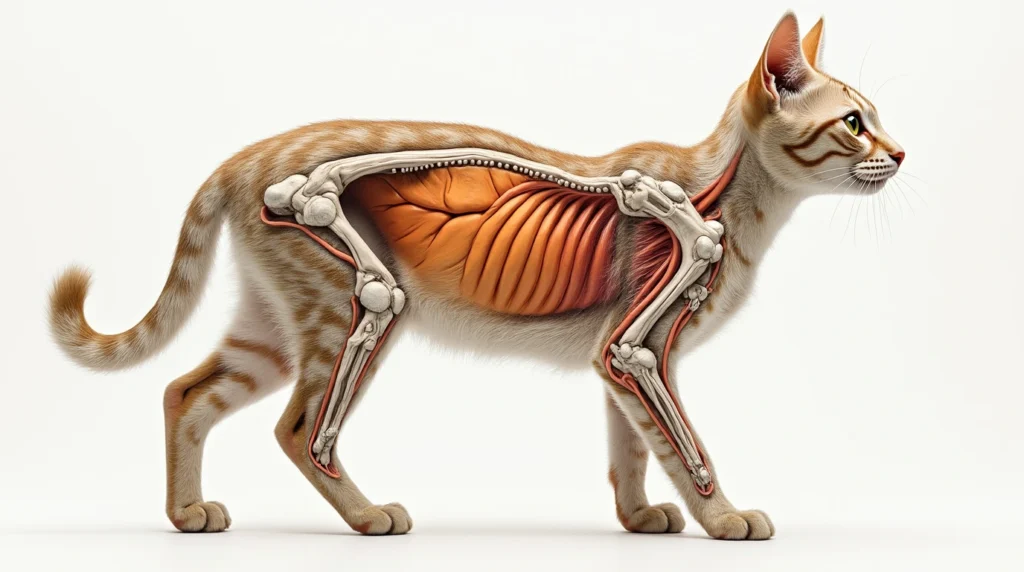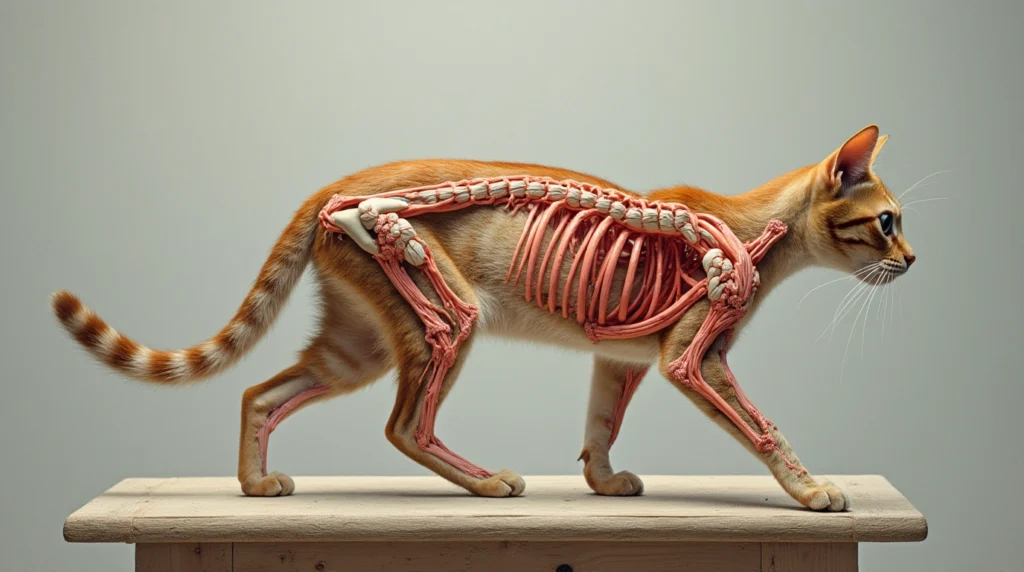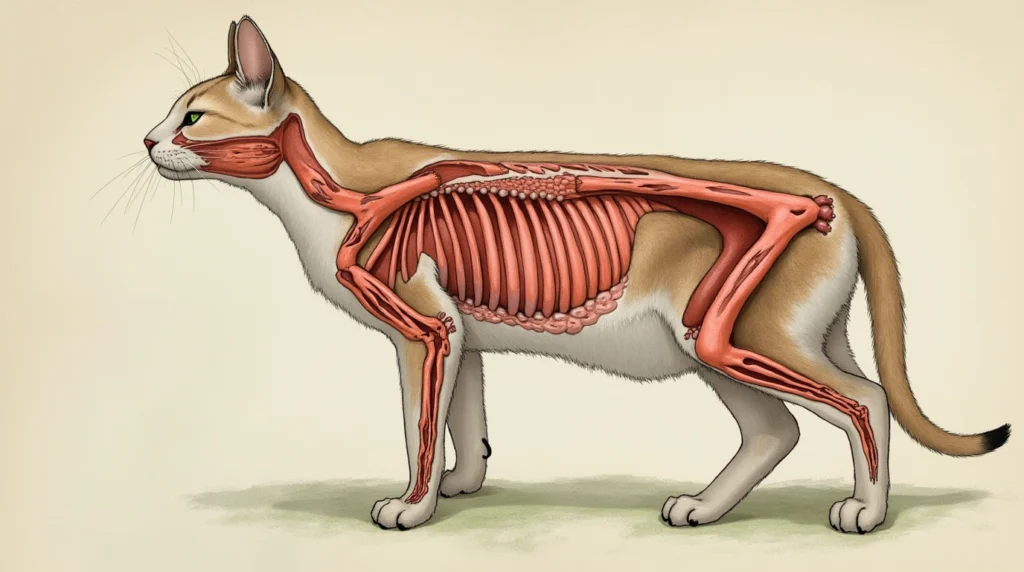If you’ve ever stared in awe at your cat’s ability to leap gracefully onto high counters or twist in midair to land softly on all fours, you’re not alone. There’s something mesmerizing about the way cats move. Behind that silky fur and those curious eyes lies a marvel of biological design. Understanding cat anatomy doesn’t just satisfy your curiosity—it helps you care for your feline friend in more informed and compassionate ways. Whether you’re a seasoned cat parent or a new cat owner, these 10 fascinating facts will deepen your appreciation for the furry creature purring on your lap.
Table of Contents
1. Cats Have 230–250 Bones – More Than Humans
You may be surprised to learn that your cat actually has more bones than you do. Humans typically have 206 bones, while cats have anywhere from 230 to 250. The variation depends mostly on the length of their tail and other small anatomical differences.
Flexible Skeleton Structure
- Cats have more vertebrae in their spine and tail, which gives them superior flexibility.
- Their bodies are designed to twist, turn, and stretch, making them excellent climbers and jumpers.
Why It Matters
- This skeletal makeup allows for impressive agility, such as squeezing through narrow gaps or turning mid-leap.
- It plays a key role in hunting, escaping predators, and everyday movement.
Tip: Keep your home enriched with cat trees or vertical spaces to support your cat’s anatomical need to climb and stretch.
2. A Cat’s Spine Can Rotate 180 Degrees
One of the most incredible parts of cat anatomy is the spine. Unlike humans, cats have a spine that can rotate up to 180 degrees. This rotation enables cats to land on their feet even when falling from high places—a reflex that kicks in as early as 3 weeks old.
Built for Stealth and Survival
- Each vertebra in your cat’s spine is loosely connected, making it incredibly flexible.
- This ability allows cats to twist their bodies in midair, a phenomenon known as the righting reflex.
Why You Should Know This
Understanding your cat’s spinal flexibility can help you identify potential injuries. If your cat is suddenly stiff or reluctant to move, it could indicate spinal pain or discomfort.

3. Cats Walk Like Camels and Giraffes
Yes, you read that right! Cats share a unique walking pattern with camels and giraffes, called a pacing gait.
Diagonal Gait Explained
- Most mammals move opposite limbs together (e.g., front left with rear right).
- Cats move both limbs on the same side before switching to the other side.
Impact on Balance and Stealth
- This gait creates a smooth, quiet walk ideal for stalking prey.
- It contributes to your cat’s reputation as a silent, efficient hunter.
Fun Fact: This same gait pattern is what makes your cat’s walk so mesmerizing to watch.
4. Their Clavicles Aren’t Connected to Other Bones
Unlike humans, your cat’s clavicles (collarbones) are not connected to other bones by joints. Instead, they are embedded in muscle.
Floating Clavicle Function
- This gives your cat the ability to fit through any space as long as their head fits.
- It adds to their agility and flexibility, especially when chasing prey or escaping danger.
Relevance to Cat Shoulder Anatomy
Understanding this feature can help you select the right harness or carrier. Ill-fitting gear can restrict your cat’s natural movement.
5. A Cat’s Tongue Is a Built-In Brush
Ever wondered why your cat’s tongue feels like sandpaper? That’s due to tiny, backward-facing barbs called papillae made of keratin.
Papillae: The Hooked Barbs
- These barbs help cats groom themselves by detangling fur and removing debris.
- They also assist in stripping meat from bones when hunting.
Grooming and Nutrition
- Your cat may swallow fur during grooming, which sometimes results in hairballs.
- Regular brushing helps reduce this and supports healthy digestion.
Pro Tip: Provide grooming support with a soft-bristle brush, especially for long-haired breeds.
6. Whiskers Are Sensory Super Tools
Whiskers do more than make your cat look cute. They’re essential for navigation and spatial awareness.
More Than Just Facial Hair
- Whiskers are deeply embedded in your cat’s skin and are rich in nerve endings.
- They help your cat detect changes in air currents and measure tight spaces.
Keyword Focus: Cat Whisker Anatomy
- Cats also have whiskers on their eyebrows, chin, and legs.
- These sensory tools send signals directly to the brain, helping with object detection and movement.
Warning: Never cut or trim your cat’s whiskers—doing so can disorient them and cause stress.
7. Cats Have a Jacobson’s Organ for Scent-Tasting
Cats have an extra olfactory organ called the Jacobson’s organ, or vomeronasal organ, that gives them an edge when it comes to detecting scents.
Located in the Roof of the Mouth
- This organ processes pheromones and other chemical signals.
- It’s activated when your cat opens its mouth slightly and curls back its lips—a behavior known as the Flehmen response.
Why This Matters
- It’s used in social bonding and detecting other cats in the area.
- It’s also why your cat seems fascinated by things you can’t smell at all.

8. Cats Hear Ultrasonic Sounds
Cats are equipped with incredibly sensitive ears. Not only can they hear sounds at a greater distance than you, but they can also pick up ultrasonic frequencies.
Superior Ear Structure
- Each ear has 32 individual muscles.
- Your cat can rotate its ears 180 degrees to pinpoint the source of a sound.
Keyword Use: Cat Ear Anatomy
- Cats can hear frequencies up to 65,000 Hz, compared to the human limit of 20,000 Hz.
- This helps them detect the ultrasonic vocalizations of small rodents.
Observation Tip: If your cat’s ears are constantly twitching, they might be picking up sounds you can’t hear.
9. Cats Don’t Taste Sweetness
You might love spoiling your pet with treats, but your cat likely isn’t interested in anything sugary.
Missing Sweet Taste Receptors
- Due to a genetic mutation, cats lack the taste receptors for sweetness.
- They don’t crave sugar because they can’t detect it.
Impact on Diet Choices
- Cats are obligate carnivores and require animal protein to thrive.
- Their dietary needs are rooted deeply in their anatomy and biology.
10. The Tail Is an Extension of the Spine
Your cat’s tail isn’t just for show—it’s a direct extension of their spine, with 19 to 23 vertebrae.
Aids in Balance and Communication
- The tail helps your cat maintain balance while climbing or running.
- It also serves as a tool for expressing mood and intention.
Tail Language Basics
- Upright = confident or happy
- Puffing up = frightened
- Twitching or flicking = annoyed or focused
Pro Tip: Pay attention to tail movements to gauge your cat’s emotional state.
Pros and Cons of Understanding Cat Anatomy
Pros cat anatomy
- Improves your ability to care for your cat
- Helps in recognizing early signs of illness or discomfort
- Deepens emotional connection through better understanding
Cons cat anatomy
- Some anatomical knowledge can be overwhelming at first
- May lead to overanalyzing normal behaviors

Conclusion: The More You Know, the Better You Love
The more you understand about cat anatomy, the better equipped you are to nurture your feline friend. From their floating clavicles to their purring tongues, every detail has a purpose rooted in nature’s genius. By learning how your cat is built, you gain insights into how they move, express themselves, and interact with the world. So the next time your cat lands silently beside you or turns its ears toward a sound only it can hear, you’ll know there’s a fascinating world behind those furry movements.
Want to explore more cat knowledge, tips, and care guides? Head over to www.meowrealm.com and dive deeper into the feline universe. Don’t forget to share this article with fellow cat lovers!
Frequently Asked Questions About Cat Anatomy
What is the most unique part of cat anatomy?
One of the most unique features is the spinal flexibility, allowing a cat to twist its body and land on its feet with remarkable precision.
How many muscles do cats have in each ear?
Each ear contains 32 muscles, allowing them to rotate independently and track sounds with incredible accuracy.
Why do cats always land on their feet?
Cats possess a built-in survival tool called the righting reflex, enabled by their highly flexible spine and inner ear balance systems.
How many bones are in a cat’s body?
Depending on tail length and genetic variation, cats have between 230 and 250 bones, compared to the 206 in humans.
Can understanding cat anatomy help in training?
Absolutely. Recognizing body language cues and anatomical responses allows for better communication, training, and bonding.
cat anatomy cat anatomy

